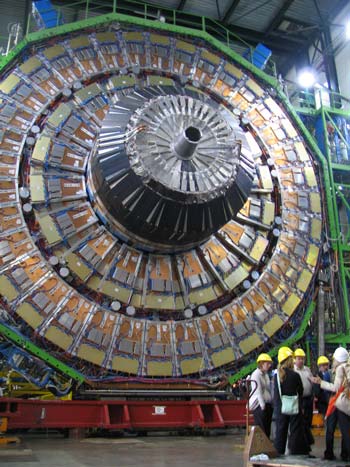Two New ISTC Projects on the CERN Large Hadron Collider (LHC)

Two new ISTC projects worth 2,4 million USD are being launched to upgrade the CERN Large Hadron Collider (LHC) injector. The LHC at CERN is the largest scientific instrument ever built. In order to fully exploit the high energy physics potential of the LHC it is foreseen to gradually upgrade the proton injector complex at CERN. The upgrade begins with so called Linac4, a linear accelerator with output energy of 160 MeV (mega electron-volts), foreseen to go into operation in 2013. Linac4 will be the first step towards the ultimate LHC parameters.
Linac4, the frontier part of the new LHC injector, consists of accelerating structures of different types, each one effective for certain energy range. The aim of the 2 new complementary ISTC projects is to cover the energy range of Linac4 between 50 and 100 MeV.
These 2 projects will result with the development and practical realization of original CCDTL (Coupled Cavity Drift Tube Linac) structures optimal for the above mentioned energies, thus constituting a substantial part of the new Linac4 accelerator. Besides, as the layout of the Linac4 is more or less typical for linear proton accelerators, the developments are interesting not only for Linac4 but, more generally, for other proton accelerators for nuclear waste transmutation, as wells as for neutron spallation sources, rare isotope manufacturing and neutrino physics. Moreover, the developed manufacturing technologies can be utilized on similar structures in other types of accelerators, e.g. for hadron therapy where a growing world market is expected.
The work will be done by Budker Institute of Nuclear Physics of Siberian Branch of Russian Academy of Sciences, Novosibirsk, and Russian Federal Nuclear Center – Russian Scientific Research Institute of Technical Physics, Snezhinsk, in cooperation with foreign collaborator/partner CERN.
The projects will last 30 months and have total values of approximately 1,100,000 and 1,300,000 US Dollars. The funds are provided via the ISTC by CERN and EU.
The ISTC supported the LHC construction through a number of projects, already completed. The activities related to the Linac4, a new LHC injector front end, were already supported as well within 3 ISTC projects aimed at the development of prototypes.

Large Hadron Collider

